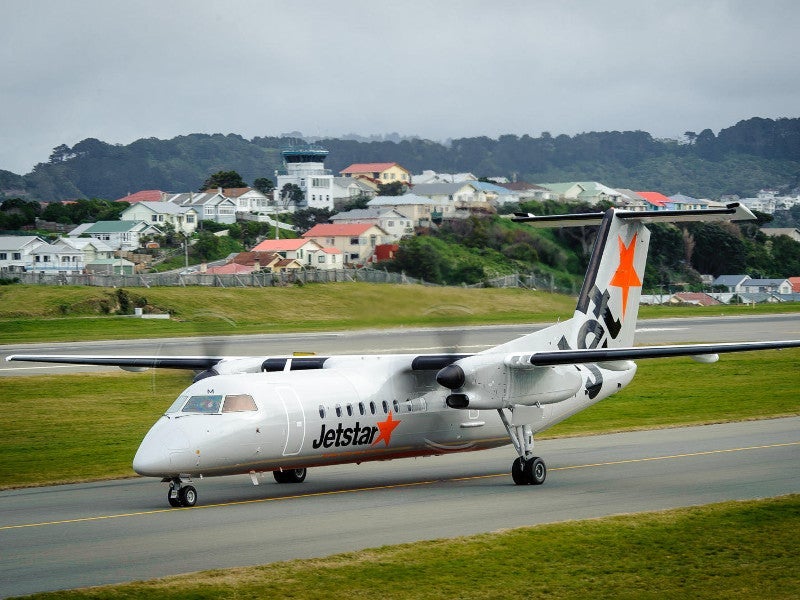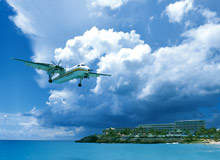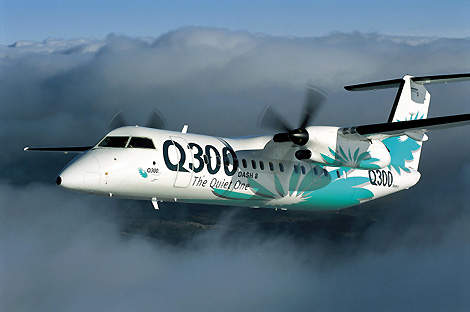The Dash 8 Q300 regional airliner was introduced in 1998 by Bombardier Aerospace De Havilland based in Downsville Ontario. The aircraft can seat up to 56 passengers. The Q series Dash 8 family also includes the Q100 (37 seats), Q200 (39 seats) and Q400 (68 to 78 seats). Orders have been received for 981 aircraft of the family with 868 delivered. The Q300 has a larger fuselage and added wingtips and has more powerful engines compared to the Bombardier Q200 airliner.
Over 267 Q300 aircraft were ordered and all of them were delivered. The aircraft are in service with Air Nippon, ALM, Augsberg Airways, Avline, Brymon Airways, GPA Jetprop, Hamburg Airline, Liat, Mark Air, National Jety, Petroleum Air Services, QantasLink, SA Express, Time Air, Tyrolean, Uni Airways, Wideroe and Zhejiang Airlines.
The Q300 aircraft is very quiet with operational noise levels of 79.5EPNdb (equivalent perceived noise decibel) for take-off, 87EPNdb sideline and 93.3EPNdb for approach.
The aircraft is fitted with the Bombardier noise and vibration suppression system (NVS). NVS technology was introduced on the Dash 8 turboprop family in 1996 and the Dash 8 series of aircraft was renamed the Q series.
Bombardier’s entire Dash 8 programme was acquired by Viking Air’s parent company Longview Aviation Capital in November 2018 in a transaction that provided the rights over all assets and intellectual property and Type Certificates of the programme to Longview. The deal included the Dash 8 programme’s 100, 200 and 300 series and the in-production Q400. Longview formed a holding company, known as De Havilland Aircraft of Canada Limited, to operate the Dash 8 business. The purchase was completed in June 2019.
Orders for the Q300 aircraft
In April 2007, Bombardier Aerospace was awarded a $56m contract by Air Philippines for supplying three Bombardier Q300 turboprop airliners.
Hawker Pacific, Australia signed a recognised service facility (RSF) agreement with Bombardier Aerospace in August 2007 for providing heavy maintenance to all Dash 8/Q-Series aircraft in the Asia-Pacific region.
A maritime surveillance variant was ordered by the Swedish Coast Guard. The prime contractor is Field Aviation Company. L-3 Communications Integrated Systems is providing the mission systems, including surveillance radar, FLIR (forward-looking infrared) and infrared line scanner. The first of three DHC-8-Q300 MSA aircraft was delivered to the Swedish coastguard in May 2008.
This variant was also ordered in March 2006 by National Air Support (NAS) of Australia on behalf of Australian customs. Three aircraft were delivered and another two were converted from the fleet of National Jet Systems. The Japanese Coast Guard selected the Q300 MSA in December 2006 with a requirement for three aircraft.
A follow-on contract for three more Bombardier Dash 8 Q300 MSA was awarded to Bombardier Aerospace in February 2009. Field Aviation modified the original Q300 into Bombardier Dash 8 Q300 maritime surveillance aircraft for Japan.
The modifications include an air-operable rear cargo door and a fuselage drop hatch, both facilitating airborne dispersal of life rafts, survival supplies and paratroops. The variant also features crew-station interior, large, conformal observation windows and fuselage structural mods. The three aircraft were delivered by January 2011.
Air Inuit was the launch customer for Bombardier Q300 Freighter with a large cargo door. The freighter was formed by modifying the passenger aircraft into a freighter aircraft.
Silverstone Airways purchased two new Q300 aircraft in 2018.
Q300 design
The Q300 fuselage is a stretched version of the Q200 fuselage. A two-plug, 3.43m extension to the Q200 fuselage design gives the Q300 an overall length of 25.7m.
The fuselage is almost circular in cross-section. The upper centre line of the fuselage carries a large dorsal fin blending with the swept vertical fin of the T-tail. The aircraft has conventional and power-assisted flight controls and a digital automatic flight control system.
Q300 cockpit
The Q300 aircraft has a dual-control cockpit with a Honeywell electronic flight instrumentation system (EFIS) interfaced to a Honeywell dual-channel digital automatic flight control system type SPZ-8000, an automatic flight director and autopilot. A flight management system can be fitted as an option.
The flight deck can be fitted with a Flight Dynamics HGS2000 head-up guidance system to give the aircraft Cat IIIa capability.
The Honeywell avionics system is the standard fit for the Q300 and a Rockwell Collins avionics suite can be fitted as an alternative.
The aircraft’s navigation suite includes a KNR 806 automatic direction finder (ADF), a KDM 706A distance measuring equipment (DME), a Honeywell Gold Crown III communications and navigation system and optional global positioning system and Primus P660 colour weather radar.
Q300 cabin
The Q300 has a longer passenger cabin, 12.65m compared to the Q200’s cabin length of 9.14m. The cabin can be configured in a single-aisle, four-abreast seating arrangement for 50 passengers in a standard seating or 56 passengers in economy class seating. The cabin is pressurised and air-conditioned with two air conditioning units. The baggage hold has a capacity of 8.5m³.
The customer airline / operator can specify an alternative cabin configuration for government, corporate and VIP cabin layouts, cargo and mixed cargo and passenger layouts.
An airstairs door is installed on the port side of the cabin forward of the wing for passengers and crew, enabling aircraft access to small airports with limited facilities. A large inward-opening door on the port side aft of the wing is for loading cargo and luggage.
Q300 engines
The Q300 airliner is equipped with two wing-mounted turboprop engines, Pratt & Whitney Canada PW123, each providing a power level of 1,775kW.
The engines drive Hamilton Sundstrand 14SF-23 four-bladed, 3.96m-diameter propellers. The propellers are fitted with an electrical de-icing system.
A high-gross weight variant of the Q300, the Q300HGW, is powered by PW 123B turbo engines, which provide increased power for operation from cold and low airport conditions. The PW123B engines are rated at 1,864kW. The HGW aircraft can carry a greater maximum payload of 6,126kg compared to the 5,166kg payload of the standard baseline Q300 version.
Another engine option, the Pratt & Whitney PW123E, rated at 1,775kW, provides the aircraft with sustained and increased power at ambient temperatures up to 40°C for operation in hot-and-high conditions.
The wing tanks store up to 3,160l of usable fuel and optional auxiliary tanks provide an additional 2,540l of fuel, giving a total fuel capacity of 5,700l. The Q300 aircraft is equipped with a Simmonds fuel monitoring system, gravity filling points in the upper wing and a single pressure refuelling point in the starboard engine nacelle.
Landing gear
The Q300 has Dowty Aerospace retractable tricycle-type landing gear fitted with twin Goodrich wheels and brakes. The landing gear is equipped with Hydro-Aire mk3 anti-skid units.
Q300 power systems
The Q300 can be fitted with an optional Turbomach T-40 auxiliary power unit. The Q300’s DC power unit comprises two starter / generator sets, two transformer and rectifier sets and two nickel-cadmium batteries. The aircraft is fitted with a DC ground receptacle installed in the nose on the port side. The aircraft’s AC power system comprises two engine-driven AC generators with three static inverters. The AC ground power receptacle is installed in rear starboard-side engine nacelle.
The aircraft has two hydraulic systems operating independently. Each hydraulic system comprises an engine-driven displacement pump, an electrically powered standby pump, an accumulator and an emergency manually operated pump.
Performance
The Bombardier Q300 DHC-8 Dash 8 aircraft can fly at a maximum cruise speed of 528km/h. Its maximum altitude is 7,620m. The maximum range of the aircraft is 1,558km. The take-off and landing length of the airliner are 1,178m and 1,041m respectively. Its maximum take-off weight is 19,505kg.






